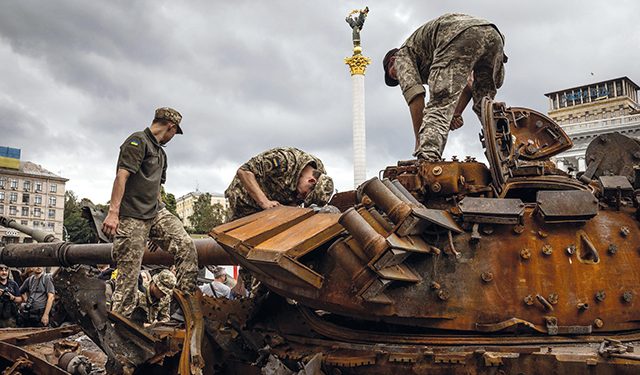Ukraine’s counteroffensive in the south of the country is gathering pace as its forces again strike bridges leading to the occupied city of Kherson in a bid to choke off supply routes for Russia’s forces there.
Meanwhile, an International Atomic Energy Agency (IAEA) convoy is said to have left the Ukrainian capital on a mission to the Russian-occupied Zaporizhzhia nuclear power plant in southeastern Ukraine on Wednesday morning.
Europe’s largest nuclear power station has become a fighting ground for the conflict, as both sides blame each other for attacks on and around the complex. Fighting around the facility has sparked fears over the heightened risk of a nuclear disaster.
Ukraine’s President Volodymyr Zelensky said in his nightly address Tuesday that Ukraine would do what it can to keep the IAEA mission safe, but that Russia was still carrying out “provocations” on areas where the IAEA mission would visit.
Members of the G-7’s non-proliferation directors group urged Russia to immediately withdraw from the Zaporizhzhia nuclear power plant.
The G-7 representatives wrote that they are “profoundly concerned by the serious threat” Russian armed forces pose to the safety and security of the facility.
“These actions significantly raise the risk of a nuclear accident or incident and endanger the population of Ukraine, neighboring states, and the international community,” the group wrote.
“The Russian Federation must immediately withdraw its troops from within Ukraine’s internationally recognized borders and respect Ukraine’s territory and sovereignty,” the group added.
“We reaffirm that the Zaporizhzhia nuclear power plant and the electricity that it produces rightly belong to Ukraine and stress that attempts by Russia to disconnect the plant from the Ukrainian power grid would be unacceptable.”
Ukraine counteroffensive has had ‘successes’ in some areas of the Kherson region, official says
Ukrainian forces have had “successes” in three areas of the Russian-occupied region of Kherson, a Ukrainian regional official said on Wednesday, according to comments reported by Reuters.
Yuriy Sobolevskyi, the deputy head of Kherson’s regional council, told Ukraine’s national news broadcaster that Ukrainian troops had enjoyed successes in the Kherson, Beryslav, and Kakhovka districts, but declined to give details.
“Now is the time to support our armed forces … Now is not the time to talk about the specific successes of our lads,” he said, echoing the Ukrainian military’s insistence on a near-total information blackout about the offensive. Kyiv announced the start of a southern counter-offensive to retake territory two days ago.
Sobolevskyi urged Ukrainians to support their armed forces with “everything they could” as the offensive was using up a vast quantity of resources.
“Right now, drones and ammunition are being used there like expendable material,” he said.
Ukrainian forces in the south of the country said they struck key bridges in the Kherson region as their counteroffensive to retake the Russian-occupied city gathers pace.
In an update on Facebook, Ukraine’s Operational Command “South” said that missile and artillery units had carried out four strikes on Russian control and command points as well as four “logistical arteries” into Kherson — the Kakhovsky, Darivsky, and two Antonivsky bridges — with the damage inflicted on the bridges restricting the Russians’ use of them as supply routes for their forces in the city.
Ukraine’s military also said that its forces had killed almost 160 Russian troops in the region and destroyed 60 pieces of enemy equipment overnight.
“In our operating area, the environment is complex but controlled. The destruction of hostile logistic paths, reserves and control points continues,” the operational update from the unit said. It added that Russia’s occupying force was “mostly demoralized, but continues to resist.”
Ukraine has pushed the front line back ‘some distance in places,’ UK says
Ukrainian armored forces have continued to assault Russia’s southern forces on several axes across the south of Ukraine since Monday, Britain’s Ministry of Defense confirmed on Wednesday.
“Ukrainian formations have pushed the front line back some distance in places, exploiting relatively thinly held Russian defenses,” the ministry said on Twitter, adding that “Russia will likely now attempt to plug the gaps in its line using pre-designated mobile reserve units.”
Russia continues to try to generate new reinforcements for its forces in Ukraine, the ministry said in its intelligence report, and could be resorting to using poorly trained troops.
“Volunteer battalions of the new 3rd Army Corps had departed their home base near Moscow by 24 August, highly likely for onward deployment to Ukraine. The operational effectiveness of these units is not known. The 3rd Army Corps is highly likely short of personnel and these troops have had limited training.”
More support coming from the US
The White House says the next security assistance package for Ukraine will be announced ‘in the coming days’
The Biden administration will announce a new security assistance package for Ukraine “in the coming days,” US National Security Council spokesman John Kirby said.
“We have committed more than $13 billion in security assistance to the Ukrainian armed forces, and we will continue to do that,” Kirby said on a conference call with reporters.
“There will be announcements of future security assistance in coming days,” he added.
Last week, to mark Ukraine’s 31 years of independence from the Soviet Union, Biden announced a US military aid package worth approximately $3 billion.
The latest arms package, the 19th such installment, is Washington’s largest since Russia’s full-scale invasion began six months ago.
NATO secretary-general speaks with German defense minister about more aid for Ukraine
NATO Secretary-General Jens Stoltenberg said he spoke with German Defense Minister Christine Lambrecht on additional ways to support Ukraine.
“Russia continues its aggressive war and winter is coming soon,” Stoltenberg warned, adding that Germany has been a strong contributor to Ukraine’s security assistance.
“Germany is already doing a lot and we will do more together in NATO,” he wrote in a tweet.
Biden administration says Putin is weaponizing energy with Nord Stream 1 shutdown
US National Security Council spokesman John Kirby called Russia’s claims that it shut down the Nord Stream 1 pipeline for “maintenance” another attempt to weaponize energy.
Russian gas giant Gazprom halted energy supplies to Europe via the pipeline in a planned “maintenance outage” expected to last until Sept. 3.
“We’re pragmatic about this and we know that there’s more work to do. So, we’re going to look into ways to increase gas stockpiles in Europe or to help bolster other sources of energy,” Kirby told reporters on a conference call.
“But, all of this work, quite frankly, is a result of Mr. Putin’s decisions to weaponize energy as he has weaponized food, and as he has weaponized information,” Kirby added.
By Ana Dumbadze














